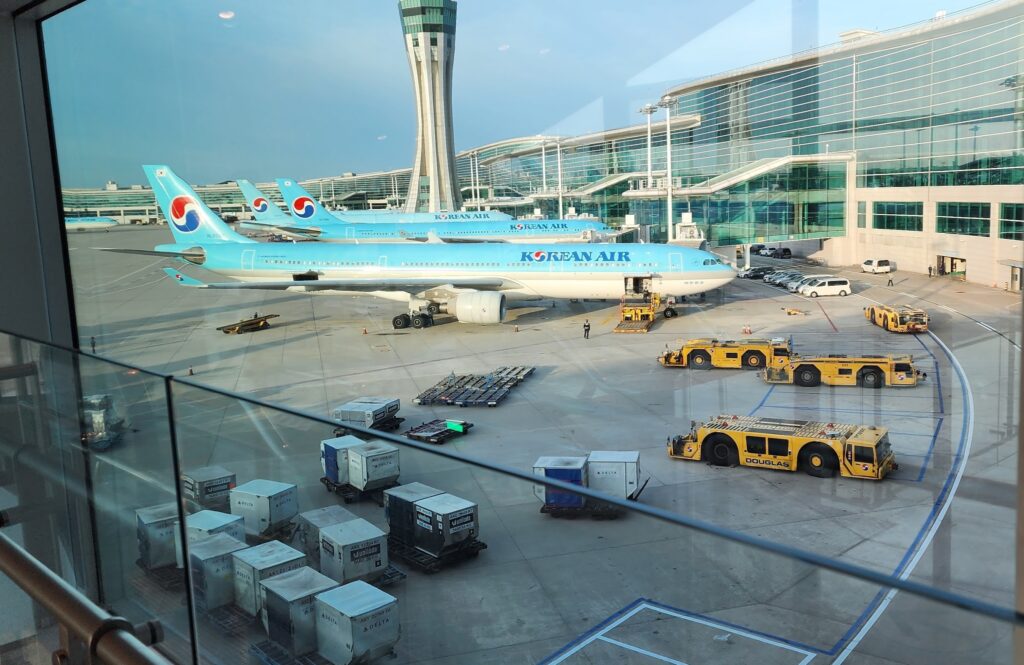Flying can be an exciting adventure in itself, or on the way to an exciting destination. However, for some people, it comes with the discomfort of ear pain. In this blog, your ENT doctor will discuss the causes of ear pain, and effective strategies to alleviate ear pain for your next flight.
What are the causes of ear pain when flying?
Ear pain during flights is primarily caused by rapid changes in air pressure and cabin altitude. As an airplane ascends, the atmospheric pressure decreases, leading to a pressure differential between the outside and inside of the ear. The middle ear, housing the eardrum and three small bones, plays a crucial role in transmitting sound and equalizing the pressure.

The eustachian tube, connecting the middle ear to the back of the throat, regulates pressure. When pressure changes occur during takeoff or descent, the eustachian tube may struggle to equalize, resulting in discomfort.
What can you do before boarding to prevent ear pain?
1. Stay Hydrated
Ensure adequate hydration before the flight to maintain optimal mucous membrane function in the ears, aiding in pressure regulation. If your body isn’t hydrated enough, your sinuses will not have the lubrication to keep your mucus at a thinner consistency. When your mucus is thick, this may make it difficult for the eustachian tube to do its work of equalization
2. Limit Alcohol and Caffeine Intake
Avoid excessive consumption of alcohol and caffeine, as they can contribute to dehydration. Dehydration, as discussed above, may potentially exacerbate ear discomfort during the flight.
3. Chew Gum or Swallow Frequently
Chewing gum helps prevent ear pain during flights by promoting frequent swallowing and jaw movements. These actions stimulate the muscles around the Eustachian tube, which connects the middle ear to the back of the throat. When you chew gum, the repetitive motion of swallowing encourages the Eustachian tube to open and close, facilitating the equalization of pressure between the middle ear and the cabin environment. This, in turn, minimizes the discomfort caused by rapid changes in air pressure during takeoff and descent.
The palate, specifically the soft palate, is connected to the Eustachian tube opening. The Eustachian tube runs from the middle ear to the nasopharynx (the upper part of the throat behind the nose). The soft palate, which is the flexible, muscular part at the back of the roof of the mouth, plays a role in the function of the Eustachian tube.
During activities like swallowing or yawning, the soft palate moves, helping to open the Eustachian tube and regulate pressure in the middle ear. This interconnected mechanism contributes to the effectiveness of strategies like chewing gum in preventing ear pain during flights.
4. Treat any ear, nose or throat problems before flight
Any problem in the ear, nose and throat may cause ear pain during flights due to their impact on the Eustachian tube and pressure regulation in the middle ear. These conditions include ear infections, sinus congestion, or nasal issues. You may take a decongestant before the flight if you have minor sniffles. However, consult with an ENT doctor near you is advised if your symptoms are more severe. Addressing ENT problems before flying is crucial because unresolved issues can intensify the effects of changes in cabin pressure, making individuals more susceptible to ear pain during the flight.
5. Perform Ear Equalization Exercises
Practice ear equalization exercises, such as the Valsalva maneuver or jaw movements, before boarding to familiarize yourself with effective techniques for equalizing ear pressure during the flight. These exercises will be discussed in the next portion of this blog
6. Avoid flight when feeling unwell
If you are in severe nasal congestion or ear pain despite medications, it is better to skip your flight than experience ear pain while in the air.
What can you do in-flight to relieve ear pressure?
Eustachian tube maneuvers help promote pressure equalization and minimize discomfort during travel. These are the following :
Valsalva Maneuver: Pinch your nostrils, close your mouth, and attempt to blow through your nose gently.
Frenzel Maneuver: involves closing the nose, closing the back of your throat, and then making a “k” or “g” sound.
Massaging the masseter and neck: sometimes tension in the nearby muscles may cause tension in the throat. You may try massaging the muscle near the angle of your jaw, as well as the side of your neck to help relax.
Toynbee Maneuver: pinch your nose and swallow simultaneously
Combination maneuvers: try a combination of Valsalva and Toynbee: While closing your nostrils, blow and swallow at the same time
Jaw maneuvers: try tensing the muscles of your soft palate and throat while pushing the jaw forward and down (like you are starting to yawn)
Chewing Gum, Yawning, Swallowing: As discussed above, chewing gum, yawning, and swallowing help promote the opening and closing of the Eustachian tube by moving the soft palate. This simple activity is an effective way to prevent and alleviate ear pain during flights.
It is important to do these activities especially before and during take off and landing as these are the times when the pressure differential between land and elevation is the biggest.
How do you get rid of earache after flying?
To alleviate earache after flying, try gently yawning, swallowing,,chewing gum to help open the eustachian tube. Applying warm compress to the affected ear and using over-the-counter ear drops may help soothe discomfort and reduce inflammation. Over the counter decongestants and pain medications may also help. However, if the earache persists or is accompanied by other concerning symptoms, consult an ENT doctor near you upon landing, so you can be managed better.
In conclusion, adopting proactive measures before boarding, such as staying hydrated, avoiding excessive alcohol and caffeine, and practicing ear equalization exercises, can significantly reduce the risk of ear pain during flights. Utilizing techniques like chewing gum, swallowing frequently, and applying warm compresses post-flight can effectively manage and alleviate ear discomfort. For persistent or severe cases, seeking guidance from a healthcare professional ensures a comprehensive approach to addressing any underlying issues associated with ear pain during air travel.
Experience expert ENT surgical care tailored to your needs.
Book now to schedule your appointment with a skilled ENT surgeon near you and take the first step towards a healthier you.
Your well-being is our top priority.

